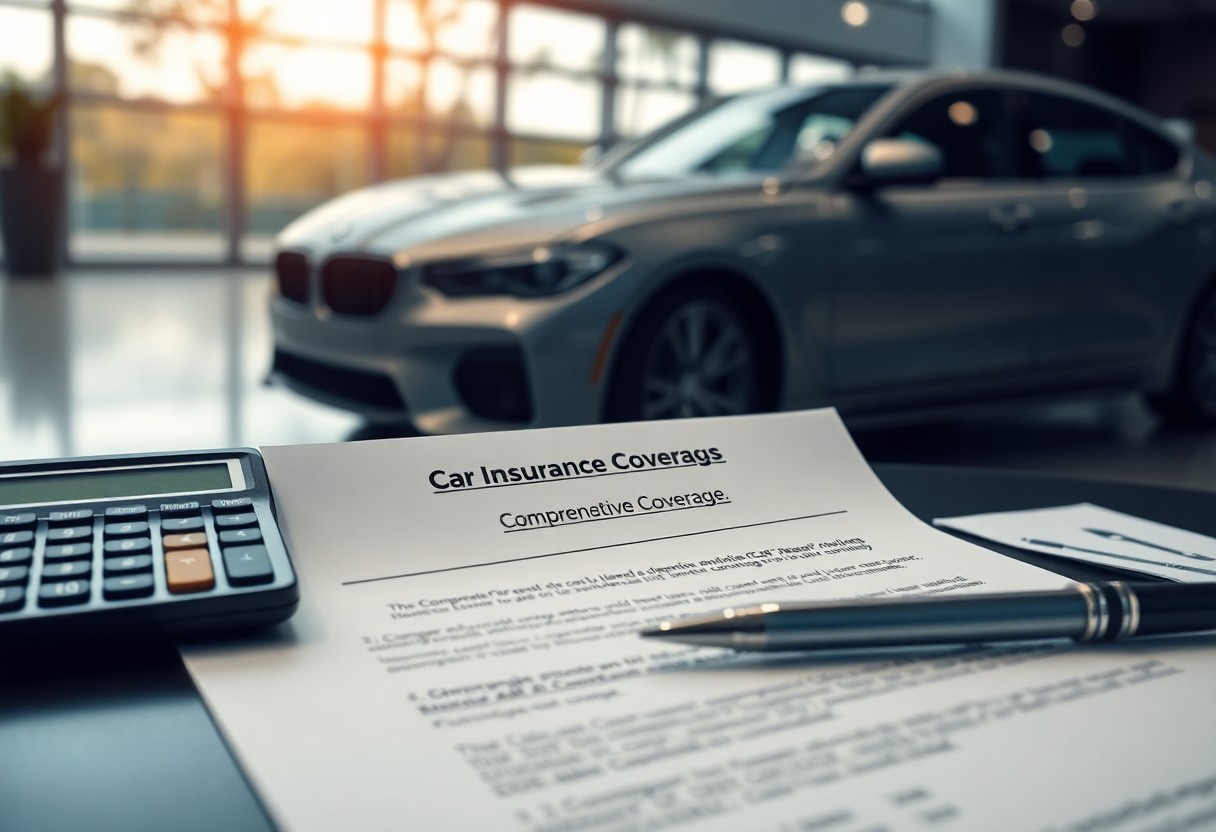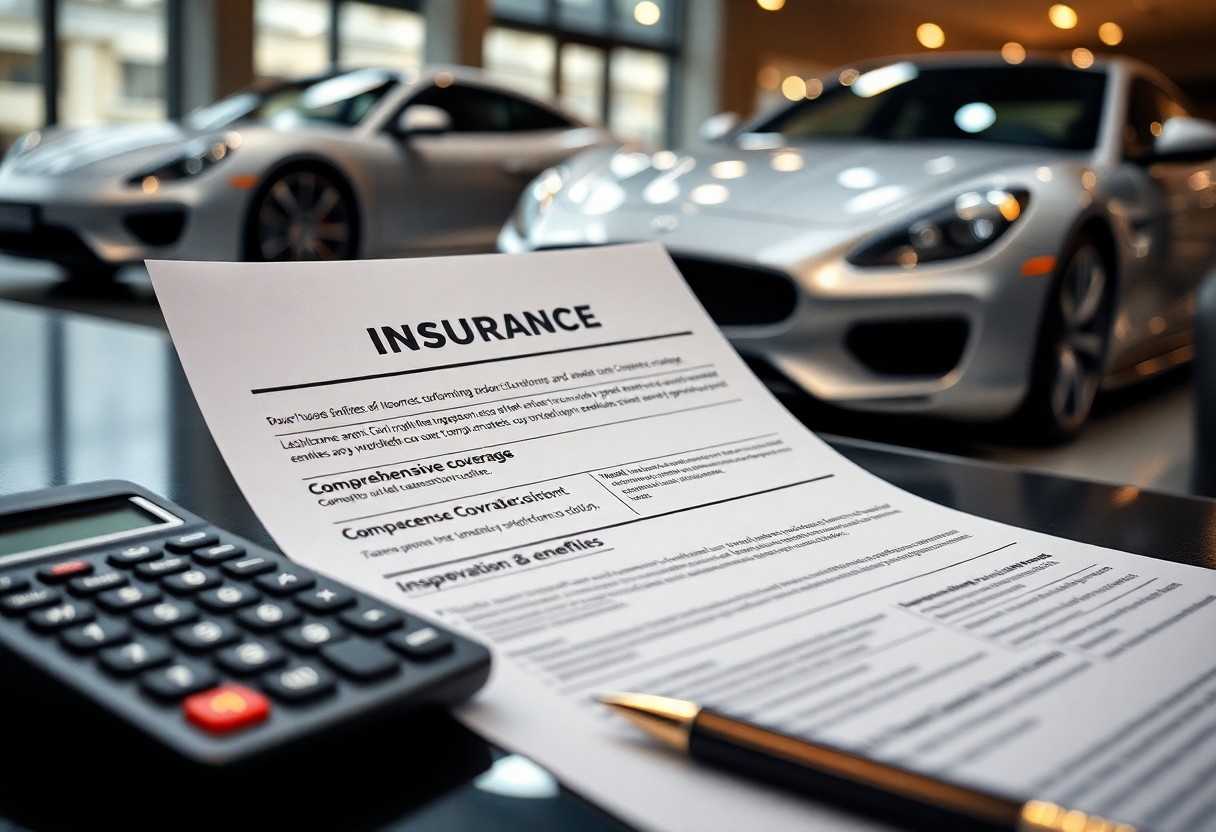You need to understand the important benefits of comprehensive car insurance to protect yourself and your vehicle. This coverage not only safeguards against damages from accidents but also shields you from losses related to theft, natural disasters, and vandalism. By choosing comprehensive insurance, you ensure that you have the financial backing necessary to handle unforeseen events, giving you peace of mind on the road. Knowing what this insurance offers can help you make informed decisions and enhance your overall driving experience.
Key Takeaways:
- Comprehensive coverage protects against non-collision incidents like theft, weather damage, and vandalism.
- It often includes coverage for personal property within the vehicle, such as electronics and valuables.
- Many policies offer benefits for medical expenses and personal injury protection, ensuring driver and passenger safety.
- Available rental car reimbursement helps drivers stay mobile while their vehicle is being repaired.
- Collision coverage can be bundled with comprehensive for a more robust protection plan.

Understanding Car Insurance
Grasping the fundamentals of car insurance enables you to make informed decisions about your coverage. It involves various policies and plans, tailored to safeguard you against financial loss related to accidents, theft, and other mishaps. A thorough understanding of your options not only helps you select the right coverage but also ensures you’re adequately protected while driving, putting you at ease behind the wheel.
Types of Car Insurance Coverage
Choosing the right car insurance involves knowing the different types of coverage available. Common options include:
- Liability Insurance: Covers damages to others if you’re at fault.
- Collision Coverage: Pays for damage to your vehicle after an accident.
- Comprehensive Coverage: Protects against non-collision incidents.
- Personal Injury Protection: Covers medical expenses for you and passengers.
- Uninsured Motorist Coverage: Protects you if involved with an uninsured driver.
Recognizing the specific benefits and limitations of each type of coverage helps you customize your policy to fit your needs.
| Type of Coverage | Description |
| Liability Insurance | Covers damage and injuries to others when you’re at fault. |
| Collision Coverage | Repairs your car after an accident, regardless of fault. |
| Comprehensive Coverage | Protects from incidents like theft or natural disasters. |
| Personal Injury Protection | Covers medical bills for you and passengers post-accident. |
| Uninsured Motorist Coverage | Provides protection when dealing with uninsured drivers. |
How Car Insurance Works
Car insurance operates on a system of risk evaluation and premium management. After assessing your driving history, vehicle type, and coverage needs, insurers determine your premium, which you pay periodically. In the event of an accident or damage, you file a claim, and the insurer compensates you based on your policy’s terms. Understanding this process empowers you to engage proactively with your insurer, ensuring you reap the full benefits of your coverage.
Insurers estimate risk using statistical data, which influences your premium amount. For example, a driver in a high-traffic area may face higher rates due to increased accident likelihood. Once a claim is filed, the insurance company assesses the incident, confirming the validity of your claim before disbursing funds for repairs or medical treatments. If you maintain a clean driving record, discounts may apply, reducing your overall costs while ensuring ongoing coverage provided by your policy.
Essential Benefits of Car Insurance
Car insurance provides crucial protection that shields you from financial losses stemming from accidents, theft, or various damages. With the right coverage, you safeguard not only your vehicle but also your assets and health. Understanding the different types of insurance benefits available can empower your decision-making process, ensuring that you choose a policy that meets your unique needs.
Liability Coverage
Liability coverage is fundamental for any car insurance policy, as it protects you against the financial consequences of causing an accident. If you’re at fault, this coverage pays for the other party’s medical expenses and property damage, safeguarding your assets. In most states, carrying a minimum amount of liability coverage is mandatory, helping to ensure responsible driving.
Collision and Comprehensive Coverage
Collision and comprehensive coverage collectively provide extensive protection for your vehicle. Collision coverage addresses damage to your car resulting from accidents, regardless of fault. Comprehensive coverage, on the other hand, shields you from non-collision incidents, such as theft, vandalism, or natural disasters. Together, they form a robust safety net, minimizing your financial exposure in unforeseen circumstances.
For example, if a tree falls on your car during a storm, comprehensive coverage would handle the repair costs. Similarly, if you collide with another vehicle or object, collision coverage ensures you won’t have to bear the full repair expense. Having both types of coverage allows you to drive confidently, knowing you’re protected from a wide range of potential damages.
Personal Injury Protection
Personal Injury Protection (PIP) covers medical expenses and sometimes lost wages for you and your passengers in the event of an accident, regardless of who is at fault. This coverage can significantly ease the financial burden of medical bills, allowing you to focus on recovery without worrying about costs.
PIP can cover a variety of medical services, including hospital stays, rehabilitation, and even some home care costs. Depending on your policy and state requirements, it may also extend to cover crucial services if you cannot perform daily tasks due to your injuries. This all-encompassing approach ensures you’re supported during a difficult time, demonstrating the importance of PIP in your insurance portfolio.
Additional Benefits to Consider
Beyond standard coverage, comprehensive car insurance can offer several additional benefits that enhance your protection and overall experience. These added features can provide peace of mind during unforeseen circumstances, ensuring you aren’t left stranded or financially burdened. Some of the more valuable options include uninsured/underinsured motorist coverage and rental car coverage, both of which can significantly impact your driving experience.
Uninsured/Underinsured Motorist Coverage
Uninsured/underinsured motorist coverage is designed to protect you in the event of an accident with a driver who lacks adequate insurance. If you’re involved in a collision where the at-fault party is uninsured or doesn’t have enough coverage to pay for your damages, this benefit ensures your medical bills and vehicle repairs are taken care of, eliminating potential financial stress.
Rental Car Coverage
Rental car coverage provides a safety net by offering reimbursement for rental expenses while your vehicle is in the shop for repairs due to a covered incident. This benefit ensures you can continue your daily activities without interruption, allowing you to rent a car without worrying about additional out-of-pocket expenses.
This coverage typically reimburses you for the full cost of a rental car up to a specified limit and for a certain duration, which can vary based on your policy. For example, if your car is being repaired for a week, this coverage can ease the financial burden, covering costs of up to $30 to $50 per day, depending on your policy terms. Opting for this benefit can significantly enhance your driving experience and alleviate stress during vehicle downtime.

Importance of Policy Customization
Customizing your car insurance policy not only tailors coverage to your unique needs but also maximizes value. By evaluating your lifestyle and driving habits, you can adjust your policy to include necessary protections while excluding unnecessary options. For an in-depth look at various coverage types, visit What Is Comprehensive Insurance?. This tailored approach ensures that you’re not overpaying for coverage you don’t need, allowing for financial efficiency while still being adequately protected.
Assessing Individual Needs
You must assess your individual needs by considering factors such as your driving frequency, vehicle type, and your financial situation. For instance, if you drive infrequently or own an older car, comprehensive coverage might not be a priority. Alternatively, if you rely heavily on your vehicle for daily commutes or family transport, investing in higher liability and collision coverage could provide necessary peace of mind.
Choosing the Right Deductible
Selecting the right deductible is a balance between monthly premium costs and out-of-pocket expenses during a claim. A higher deductible typically means lower premiums, but it also leads to more substantial costs when an incident occurs. Conversely, choosing a lower deductible results in higher premiums but less financial strain if you need to file a claim.
For optimal cost management, weigh your financial capacity against the likelihood of needing to make a claim. If you can comfortably cover a higher deductible, it may be worth saving on premiums. Many insurers allow you to adjust deductibles, providing flexibility to adapt your coverage as your financial situation changes or as you gain more experience on the road. Balancing deductibles thoughtfully can significantly impact both your ongoing costs and your financial security during unexpected events.
Common Car Insurance Myths
Car insurance comes with numerous myths that can mislead you into making uninformed decisions. Many believe that all coverage is the same or that only new vehicles need comprehensive protection. You might also think that a clean driving record guarantees the lowest premiums or that filing one claim will significantly increase your costs. Such misconceptions can lead to inadequate coverage or higher costs, emphasizing the necessity of understanding your policy correctly.
Misconceptions About Premium Costs
Many drivers assume that their premium costs will remain constant over time. In reality, your premiums can change due to various factors, including changes in your credit score, claims history, and even the type of vehicle you drive. Additionally, regional factors like crime rates or weather patterns can impact rates. Taking proactive steps, such as maintaining a good driving record and exploring discounts, can help lower your costs.
Understanding Claims Process
The claims process can often seem daunting, leaving many drivers unsure of the next steps after an accident. After notifying your insurer, documenting the incident becomes imperative. This includes collecting photos, police reports, and witness statements. Following your claim submission, your adjuster will assess damages and determine coverage eligibility. Clear communication with your insurer at every stage will keep you informed and expedite the process.
During the claims process, timeliness and accuracy are key components. It’s advisable to file your claim as soon as possible post-accident to avoid potential delays. Insurers often have specific timeframes for claims submission, which you’ll want to respect. Be prepared to provide all necessary documentation, including your policy number and details of the incident, which can drastically influence the speed at which your claim is resolved. Keeping a record of communications with your insurance company can also help clarify any discrepancies and ensure a smoother claims experience.
Tips for Finding the Best Car Insurance
Finding the best car insurance involves thorough research and consideration of multiple factors. Focus on understanding your specific needs, comparing coverage options, and considering local regulations. Use the following tips to guide your search:
- Assess your coverage needs.
- Gather and compare multiple quotes.
- Investigate discounts and special offers from insurers.
- Read customer reviews for insights into service quality.
- Consult insurance agents for expert advice.
Assume that diligent research will yield the most suitable insurance for your driving situation.
Comparing Quotes
When comparing quotes, look beyond just the premiums. Examine the details and coverages to truly understand what each policy offers. A comprehensive side-by-side comparison enables you to discern the best value for your budget and protection level.
| Insurance Company | Monthly Premium |
|---|---|
| Company A | $100 |
| Company B | $120 |
| Company C | $90 |
Understanding Discounts and Offers
Many car insurance companies provide various discounts and offers that can significantly reduce your premiums. Discounts may include safe driver discounts, multi-policy discounts, and student discounts, among others. Always inquire about available promotions when obtaining quotes.
Every insurer has a unique range of discounts that may apply to your situation. For instance, completing a certified driving course can lead to a noteworthy reduction in your premium. Additionally, bundling auto insurance with homeowners or renters insurance typically yields substantial savings. Evaluate each offer closely, as combining multiple discounts can lead to significant savings on your overall policy. Always ask your agent for potential savings to maximize your policy’s value.
Conclusion
Now that you understand the comprehensive car insurance benefits every driver needs, you can make informed decisions to protect your vehicle and finances. With coverage for theft, natural disasters, and vandalism, you ensure that you’re safeguarded against unforeseen events. Investing in comprehensive insurance provides peace of mind, allowing you to focus on the road ahead. Prioritize your coverage options to enhance your driving experience and ultimately protect your interests.
FAQ
Q: What is comprehensive car insurance?
A: Comprehensive car insurance covers a wide range of incidents, including theft, vandalism, natural disasters, and damage caused by animals, in addition to typical collision coverage.
Q: What benefits does comprehensive insurance provide for vehicle theft?
A: If your car is stolen, comprehensive insurance can help cover the loss by reimbursing you for the vehicle’s value at the time of loss, subject to your deductible.
Q: How does comprehensive coverage assist with natural disasters?
A: Comprehensive insurance pays for damages to your vehicle caused by natural disasters such as floods, hurricanes, or earthquakes, ensuring you are not financially burdened by expensive repairs.
Q: Are there any additional benefits associated with comprehensive car insurance?
A: Yes, comprehensive insurance may also provide benefits such as emergency roadside assistance, rental car reimbursement, and coverage for personal belongings stolen from the vehicle.
Q: How can I determine if comprehensive insurance is right for me?
A: Consider factors such as the value of your vehicle, your location’s risk factors (like crime rates and weather), and your overall budget to assess whether comprehensive insurance aligns with your needs.





0 Comments